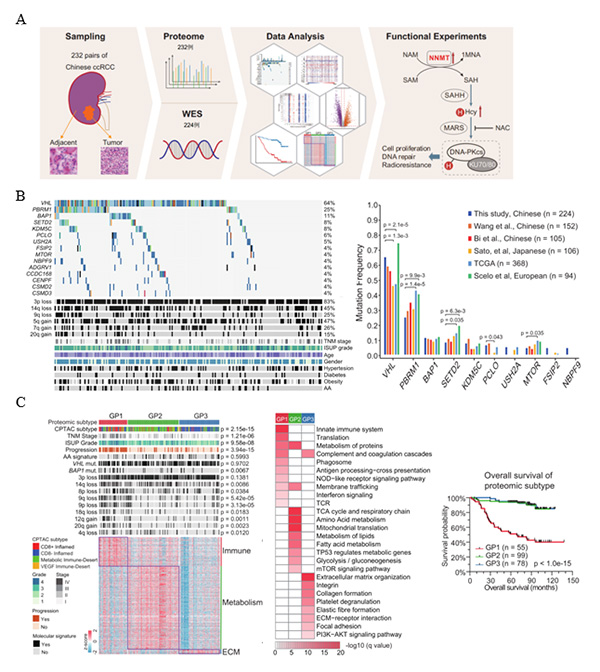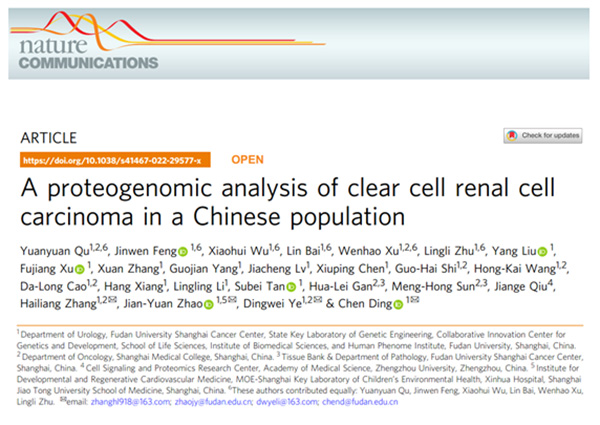NEWSROOM
-
China is a country with the large number of kidney cancer, and about 40% of patients are diagnosed with metastatic renal cancer or occure distant metastasis during disease follow-up, which leads to poor treatment outcomes. High genetic heterogeneity and lack of precise and effective therapeutic targets are the main reasons for the poor treatment outcome of renal cancer. The team of Professor Dingwei Ye from the Department of Urology, Fudan University Shanghai Cancer Center, together with the team of Professor Chen Ding from the Institute of Human Phenotyping of Fudan University and the team of Professor Jianyuan Zhao from Xinhua Hospital of Shanghai Jiaotong University School of Medicine, have successfully mapped the proteogenomic profile of Chinese clear cell renal cell carcinoma (ccRCC). The study performed molecular typing based on the proteomic expression profile, which provided new targets and a theoretical basis for the precise treatment of ccRCC. The research titled "A proteogenomic analysis of ccRCC in a Chinese population" was published in 《Nature Communications》 on April 19, 2022.
In 2020, more than 73,000 patients were diagnosed with kidney cancer in China, surpassing the United States to become the country with the largest number of kidney cancer in the world. Although targeted therapy or immunotherapy has improved the treatment efficiency for advanced kidney cancer, the response to the treatments varies greatly among individual patients. The team of Professor Dingwei Ye from the Department of Urology, Fudan University Shanghai Cancer Center, together with the team of Professor Chen Ding from the Institute of Human Phenotyping of Fudan University and the team of Professor Jianyuan Zhao from Xinhua Hospital of Shanghai Jiaotong University School of Medicine, joint performed proteogenomic sequencing analysis of 232 cases of ccRCC in Chinese population. The present study is the first to delineate the proteogenomic expression profile of Chinese clear cell renal cancer through a large sample cohort. The highest mutation rate of the genes was found to be VHL (64.3%), followed by PBRM1 (24.5%), BAP1 (10.7%), and SETD2 (8.9%). The mutation frequencies of key pathogenic genes in the Chinese ccRCC population were significantly different from those in the European and American populations. The European cohort had higher mutation rates of VHL and SETD2, the TCGA cohort had higher mutation rates of PBRM1 and MTOR, however, PBRM1和SETD2 mutation rates were lower in the Chinese cohort. Molecular typing divides ccRCC patients into immuno-infiltrative (GP1), metabolically altered (GP2) and mesenchymal predominant (GP3) types based on their proteomic expression profiles. Among them, the GP1 subtype is the most malignant, most aggressive, and with the worst prognosis, suggesting the need for more aggressive treatment. This study further disclosed the molecular mechanism of ccRCC carcinogenesis. Nicotinamide N-methyltransferase (NNMT), an important methylation catalase, could activate DNA-PKcs, a key protein in DNA damage repair, and enhance DNA repair which in return promotes the proliferation of renal cancer cells (Figure 1). This finding suggested that NNMT could not only be a potential biomarker for ccRCC, but also a potential drug target for the GP1 subtype.
Prof. Dingwei Ye noted that this achievement is the first to depict the proteogenomic expression profile of ccRCC in the Chinese population and to discover the differences in the mutation spectrum of key pathogenic genes of ccRCC between China and the West. The results of this study provide a new target for intervention in the precise treatment of ccRCC, and the molecular typing based on the proteomic expression profile provides a theoretical basis for the precise treatment of ccRCC.

Figure 1. Protein genome analysis of 232 cases of clear renal carcinoma in Chinese population
A. Schematic diagram of multi-omics analysis; B. Comparison of gene mutation profiles between this study and Western cohorts; C. Proteomic subtyping (Link to original article: https://www.nature.com/articles/s41467-022-29577-x)


